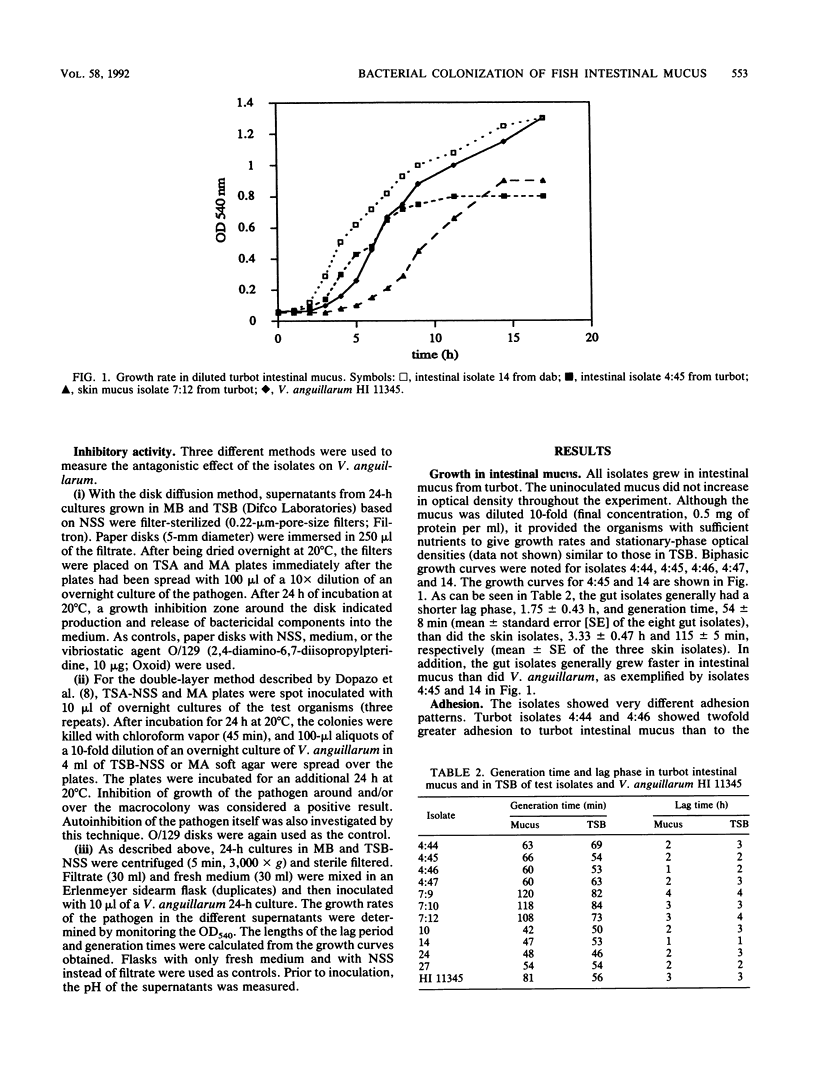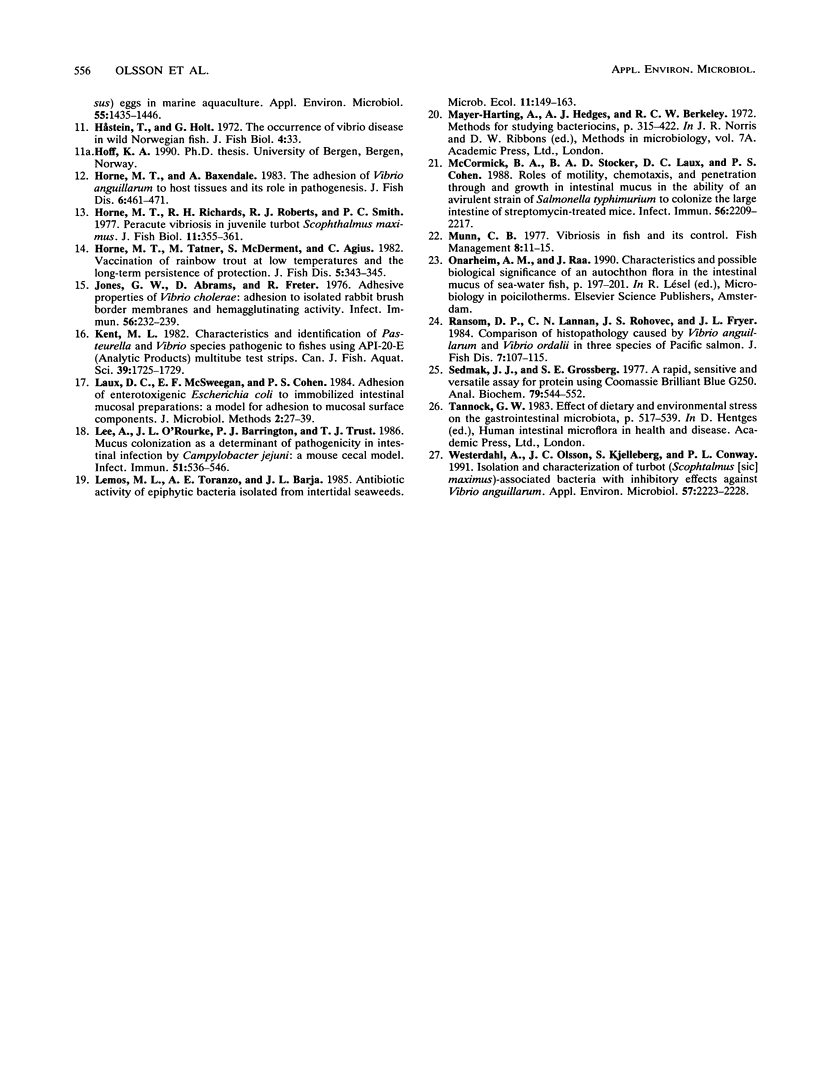Abstract
Of more than 400 bacteria isolated from turbot (Scophthalmus maximus), 89 have previously been shown to inhibit the in vitro growth of the fish pathogen Vibrio anguillarum. The aim of the present study was to investigate the potential of seven of these strains, as well as of intestinal isolates (four strains) from a closely related fish, dab (Limanda limanda), for colonizing farmed turbot as a means of protecting the host from infection by V. anguillarum. In addition, the inhibitory effect of these strains on the pathogen was further studied. Colonization potential was measured by the capacity of the strains to adhere to and grow in turbot intestinal mucus. These parameters were also used to investigate the potential of V. anguillarum to amplify in the turbot intestinal tract. Because of the observed rapid growth of V. anguillarum in intestinal mucus, it can be proposed that the intestinal tract is a site for V. anguillarum multiplication. Strains isolated from the intestine showed greater capacity for adhesion to and growth in fish intestinal mucus than did the pathogen and the skin mucus isolates. All of the isolates released metabolites into the culture medium that had inhibitory effects against V. anguillarum. The results are discussed with emphasis on administering bacteria of host origin to farmed turbot in order to control V. anguillarum-induced disease.
Full text
PDF





Selected References
These references are in PubMed. This may not be the complete list of references from this article.
- Aoki T. Effects of chemotherapeutics on bacterial ecology in the water of ponds and the intestinal tracts of cultured fish, ayu (Plecoglossus altivelis). Jpn J Microbiol. 1975 Feb;19(1):7–12. doi: 10.1111/j.1348-0421.1975.tb00841.x. [DOI] [PubMed] [Google Scholar]
- Conway P. L., Welin A., Cohen P. S. Presence of K88-specific receptors in porcine ileal mucus is age dependent. Infect Immun. 1990 Oct;58(10):3178–3182. doi: 10.1128/iai.58.10.3178-3182.1990. [DOI] [PMC free article] [PubMed] [Google Scholar]
- Dopazo C. P., Lemos M. L., Lodeiros C., Bolinches J., Barja J. L., Toranzo A. E. Inhibitory activity of antibiotic-producing marine bacteria against fish pathogens. J Appl Bacteriol. 1988 Aug;65(2):97–101. doi: 10.1111/j.1365-2672.1988.tb01497.x. [DOI] [PubMed] [Google Scholar]
- Enger O., Husevåg B., Goksøyr J. Presence of the fish pathogen Vibrio salmonicida in fish farm sediments. Appl Environ Microbiol. 1989 Nov;55(11):2815–2818. doi: 10.1128/aem.55.11.2815-2818.1989. [DOI] [PMC free article] [PubMed] [Google Scholar]
- Jones G. W., Abrams G. D., Freter R. Adhesive properties of Vibrio cholerae: adhesion to isolated rabbit brush border membranes and hemagglutinating activity. Infect Immun. 1976 Jul;14(1):232–239. doi: 10.1128/iai.14.1.232-239.1976. [DOI] [PMC free article] [PubMed] [Google Scholar]
- Lee A., O'Rourke J. L., Barrington P. J., Trust T. J. Mucus colonization as a determinant of pathogenicity in intestinal infection by Campylobacter jejuni: a mouse cecal model. Infect Immun. 1986 Feb;51(2):536–546. doi: 10.1128/iai.51.2.536-546.1986. [DOI] [PMC free article] [PubMed] [Google Scholar]
- McCormick B. A., Stocker B. A., Laux D. C., Cohen P. S. Roles of motility, chemotaxis, and penetration through and growth in intestinal mucus in the ability of an avirulent strain of Salmonella typhimurium to colonize the large intestine of streptomycin-treated mice. Infect Immun. 1988 Sep;56(9):2209–2217. doi: 10.1128/iai.56.9.2209-2217.1988. [DOI] [PMC free article] [PubMed] [Google Scholar]
- Sedmak J. J., Grossberg S. E. A rapid, sensitive, and versatile assay for protein using Coomassie brilliant blue G250. Anal Biochem. 1977 May 1;79(1-2):544–552. doi: 10.1016/0003-2697(77)90428-6. [DOI] [PubMed] [Google Scholar]
- Westerdahl A., Olsson J. C., Kjelleberg S., Conway P. L. Isolation and characterization of turbot (Scophtalmus maximus)-associated bacteria with inhibitory effects against Vibrio anguillarum. Appl Environ Microbiol. 1991 Aug;57(8):2223–2228. doi: 10.1128/aem.57.8.2223-2228.1991. [DOI] [PMC free article] [PubMed] [Google Scholar]


